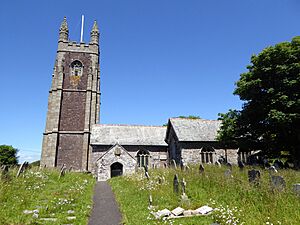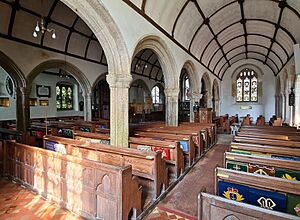St Mary's and St Julian's Church, Maker facts for kids
Quick facts for kids St Mary's and St Julian's Church, Maker |
|
|---|---|
 |
|
| 50°20′50″N 4°11′06″W / 50.3472°N 4.1850°W | |
| Location | Maker, Cornwall, England |
| Denomination | Church of England |
| History | |
| Status | Active |
St Mary's and St Julian's Church is a beautiful old church in Maker, Cornwall, England. It is a Church of England parish church. The church was built in the 1400s. It has been a very important building, known as a Grade I listed building, since 1968. This means it is a special historic building that needs to be protected.
Contents
The Church's History
The church you see today was mostly built in the 1400s. Some parts, like the main hall (nave) and the area around the altar (chancel), might be even older. Records show there was a church in Maker as early as the 1100s.
Because the church is in a high place, its tower was a great landmark for sailors. In the 1700s and during the Napoleonic Wars, the tower was even used as a signal station by the navy. They would send messages from there!
Big Changes in the 1870s
By the 1870s, many parts of the church were old and falling apart. The windows, seats, roof, and floor all needed fixing. In 1866, a new vicar, Rev. F. T. Wintle, started raising money to fix the church.
A group was formed, and James Piers St Aubyn was hired as the architect. Philip Blowey was the builder. The work cost about £1,662, plus £75 for a new heating system. Important people like the Earl of Mount Edgcumbe helped pay for the repairs.
What Was Fixed?
The entire church got a new roof. The inside was greatly improved. New wooden seats were put in, and the chancel area got new wooden panels. The floor was relaid with special patterned tiles.
Old viewing areas (galleries) were removed. This made space for a new side section called the south aisle. Its arches were made from strong granite stone. During the work, an old fireplace was found. Its chimney was used for the new heating system.
The Earl of Mount Edgcumbe also paid for a special stained-glass window. It was made to remember his aunts and his father's older brother.
Reopening and New Organs
The church officially reopened on June 18, 1874. The Bishop of Exeter, Frederick Temple, and the Earl's family attended the event. In 1875, the church got a new organ. It was built by Hele & Co. of Plymouth and cost £230.
To help people in nearby villages, two smaller churches were opened. One was at Cremyll Schoolroom in 1867. Another, St Paul's, opened in 1882 for the village of Kingsand.
Church Design and Features
St Mary's and St Julian's Church is built from local red sandstone. It has special granite decorations. The church is built in a style called Perpendicular style, which was popular in the late Middle Ages.
The church has several main parts. These include the nave (main area), north and south aisles (side sections), chancel (altar area), and a north transept (a side wing). There is also a south porch and a tall, three-part tower at the west end.
The new south aisle, added in the 1870s, is known as the Edgcumbe Chapel. The church's font, used for baptisms, is from the 1100s. It used to be in another church called St Merryn.
Above the entrance, there is a sundial from 1768. A special stone basin for holy water was found in the churchyard in 1923. The tower holds six bells. These bells were remade in 1808 but are much older than that.
Memorials and Monuments
The church has many monuments inside. These are special plaques or stones that remember people who have passed away.
|
In the Tower
In the North Aisle
|
In the South Aisle
In the Chancel
In the Edgcumbe Chapel
|
Churchyard Headstones
In 1987, many of the old headstones in the churchyard also became Grade II listed. This means they are important historical items too.
|
|
Other Grade II listed monuments in the churchyard include:
- A chest tomb for John Skardon and his family, 1775
- A ledger stone for Judith Beale from the 1700s (date hard to read)
- An old chest tomb from the early 1800s (date hard to read)
- An obelisk for Christian Lyne Walkom and her family, 1868
- A chest tomb for Richard Rule and his family, 1871


